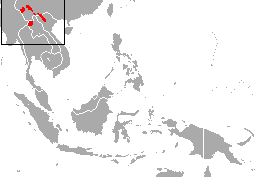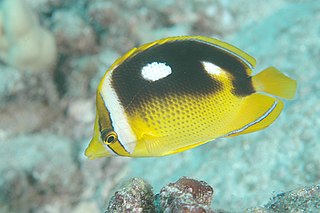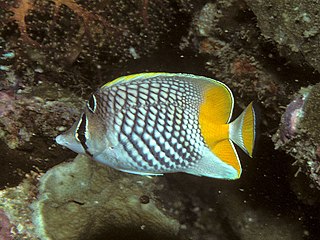
Triggerfish are about 40 species of often brightly colored fish of the family Balistidae. Often marked by lines and spots, they inhabit tropical and subtropical oceans throughout the world, with the greatest species richness in the Indo-Pacific. Most are found in relatively shallow, coastal habitats, especially at coral reefs, but a few, such as the oceanic triggerfish, are pelagic. While several species from this family are popular in the marine aquarium trade, they are often notoriously ill-tempered.

Gobiidae or gobies is a family of bony fish in the order Gobiiformes, one of the largest fish families comprising more than 2,000 species in more than 200 genera. Most of gobiid fish are relatively small, typically less than 10 cm (3.9 in) in length, and the family includes some of the smallest vertebrates in the world, such as Trimmatom nanus and Pandaka pygmaea, Trimmatom nanus are under 1 cm long when fully grown, then Pandaka pygmaea standard length are 9 mm (0.35 in), maximum known standard length are 11 mm (0.43 in). Some large gobies can reach over 30 cm (0.98 ft) in length, but that is exceptional. Generally, they are benthic or bottom-dwellers. Although few are important as food fish for humans, they are of great significance as prey species for other commercially important fish such as cod, haddock, sea bass and flatfish. Several gobiids are also of interest as aquarium fish, such as the dartfish of the genus Ptereleotris. Phylogenetic relationships of gobiids have been studied using molecular data.

The butterflyfish are a group of conspicuous tropical marine fish of the family Chaetodontidae; the bannerfish and coralfish are also included in this group. The approximately 129 species in 12 genera are found mostly on the reefs of the Atlantic, Indian, and Pacific Oceans. A number of species pairs occur in the Indian and Pacific Oceans, members of the huge genus Chaetodon.

Animal sexual behaviour takes many different forms, including within the same species. Common mating or reproductively motivated systems include monogamy, polygyny, polyandry, polygamy and promiscuity. Other sexual behaviour may be reproductively motivated or non-reproductively motivated.

In biology, a pair bond is the strong affinity that develops in some species between a mating pair, often leading to the production and rearing of young and potentially a lifelong bond. Pair-bonding is a term coined in the 1940s that is frequently used in sociobiology and evolutionary biology circles. The term often implies either a lifelong socially monogamous relationship or a stage of mating interaction in socially monogamous species. It is sometimes used in reference to human relationships.
Monogamous pairing in animals refers to the natural history of mating systems in which species pair bond to raise offspring. This is associated, usually implicitly, with sexual monogamy.

The black crested gibbon is a Critically Endangered species of gibbon found in China, Laos, and northern Vietnam, with four subspecies.

The ornate butterflyfish, or clown butterflyfish is a species of marine ray-finned fish, a butterflyfish in the family Chaetodontidae.

The four-spotted butterflyfish or fourspot butterflyfish is a species of butterflyfish found in the Pacific Ocean from the Ryukyus, Ogasawara (Bonin) Islands and Taiwan to the Hawaiian, Marquesan, and Pitcairn islands, south to the Samoan and Austral Islands and the Marianas and Marshall Islands in Micronesia.

The lined butterflyfish is a species of marine ray-finned fish. a butterflyfish belonging to the family Chaetodontidae, one of the largest species in the genus Chaetodon. It has a wide range from the Red Sea to South Africa and as far east as southern Japan and Hawaii.

The melon butterflyfish or the Indian redfin butterflyfish, is a species of marine ray-finned fish, a butterflyfish belonging to the family Chaetodontidae. It is found in the Indian Ocean from East Africa to Western Java. This is one species of a closely related group which includes the blacktail butterflyfish of the Red Sea and Gulf of Aden and the oval butterflyfish which is found in the western Pacific, from eastern coasts of the Indonesian islands to Australia.

The pearlscale butterflyfish, also known as yellow-tailed butterflyfish, crosshatch butterflyfish or Philippines chevron butterflyfish is a species of marine ray-finned fish, a butterflyfish belonging to the family Chaetodontidae.

Elacatinus is a genus of small marine gobies, often known collectively as the neon gobies. Although only one species, E. oceanops, is technically the "neon goby", because of their similar appearance, other members of the genus are generally labeled neon gobies, as well. Except for a single East Pacific species, all reside in warmer parts of the West Atlantic, including the Caribbean and Gulf of Mexico. They are known for engaging in symbiosis with other marine creatures by providing them cleaning service that consists of getting rid of ectoparasites on their bodies. In return, Elacatinus species obtain their primary source of food, ectoparasites.

The oval butterflyfish, red-finned butterflyfish or redfin butterflyfish, is a species of marine ray-finned fish, a butterflyfish belonging to family Chaetodontidae. It is found in the Pacific Ocean from Eastern Indonesia to the Hawaiian islands. This is one species of a closely related group which includes the blacktail butterflyfish, which is found in the Red Sea and Gulf of Aden, and the melon butterflyfish, which is found in the Indian Ocean.

The Indian vagabond butterflyfish, also known as the blackened butterflyfish or black-finned vagabond, is a species of marine ray-finned fish, a butterflyfish belonging to the family Chaetodontidae. It is found in the Indo-West Pacific, from the Maldives via India, Sri Lanka and the Andaman Sea to the westernmost portion of the Indonesian archipelago.

Chaetodon xanthocephalus, known commonly as the Yellowhead butterflyfish, is a species of marine fish in the family Chaetodontidae. It is found in the Indian Ocean.

Forcipiger longirostris, commonly known as the longnose butterflyfish or big longnose butterflyfish, is a species of butterflyfish found on coral reefs throughout the tropical waters of the Indo-Pacific. Even with its distinctive, point-like long nose, the longnose butterflyfish still can easily be confused with its more common cousin F. flavissimus. Both species may be kept in aquariums.

The pebbled butterflyfish is a species of marine fish, a butterflyfish from the family Chaetodontidae. It is often found near reefs. They are at most 12 centimetres (4.7 in) in length, and white with yellow, brown, and black markings. These butterflyfish are territorial and form pairs. The pebbled butterflyfish occur near reefs in the eastern central Pacific, and are endemic to waters off the Hawaiian Islands and Johnston Atoll. They have a role in aquarium trade.

The term seabird is used for many families of birds in several orders that spend the majority of their lives at sea. Seabirds make up some, if not all, of the families in the following orders: Procellariiformes, Sphenisciformes, Pelecaniformes, and Charadriiformes. Many seabirds remain at sea for several consecutive years at a time, without ever seeing land. Breeding is the central purpose for seabirds to visit land. The breeding period is usually extremely protracted in many seabirds and may last over a year in some of the larger albatrosses; this is in stark contrast with passerine birds. Seabirds nest in single or mixed-species colonies of varying densities, mainly on offshore islands devoid of terrestrial predators. However, seabirds exhibit many unusual breeding behaviors during all stages of the reproductive cycle that are not extensively reported outside of the primary scientific literature.
Polygyny is a mating system in which one male lives and mates with multiple females but each female only mates with a single male. Systems where several females mate with several males are defined either as promiscuity or polygynandry. Lek mating is frequently regarded as a form of polygyny, because one male mates with many females, but lek-based mating systems differ in that the male has no attachment to the females with whom he mates, and that mating females lack attachment to one another.



















